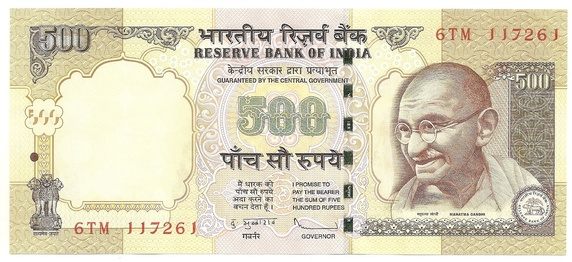
One of the many theories offered in favour of demonetisation or notebandi, has been that it has led to lower interest rates. The demonetised notes of Rs 500 and Rs 1,000 had to be deposited into the banks, where the money would be credited against the depositors’ name.
This has essentially led to the total amount of deposits with banks increasing at a rapid rate. Between October 28, 2016, before the demonetisation happened, and January 20, 2017, the total deposits of banks went up by 5.7 per cent. This increase in a period of under three months is huge.
With an increase in deposits, banks have cut interest rates. The logic offered by many experts was that this cut in interest rates will lead to an increase in lending by banks and that would be good for the economy. But the data suggests that anything like that hasn’t happened.
Take a look at Figure 1. It essentially shows the portion of bank deposits that have been invested in government securities, in the recent past.
Figure 1:

What does Figure 1 tell us? As on October 28, 2016, before demonetisation was carried out, around 29 per cent of bank deposits had been invested in government securities. As on January 20, 2017, the latest data that is available, the proportion had jumped to 34.1 per cent. Banks need to compulsorily invest just 20.5 per cent of their deposits in government securities.
Further, between October 28, 2016, and January 20, 2017, the total amount of money banks got as deposits stands at Rs 5.63 lakh crore. During the same period, the total amount of money banks invested in government securities was Rs 6.99 lakh crore. This basically means that during the period under consideration 124 per cent of the money that came in as bank deposits was invested into government securities. Hence, not only all the deposits that came in between October 28, 2016, and January 20, 2017, have been invested by banks into government securities, some of the earlier deposits have also been invested into government securities.
Given that cash is fungible, this basically means that on the whole banks haven’t loaned out any of the deposits that have come after demonetisation. All that money has been invested into government securities.
Now let’s take a look at Figure 2. This essentially plots the portion of bank deposits which have been given out as loans (i.e. non-food credit). Banks give working-capital loans to the Food Corporation of India to carry out its operations, those have been adjusted for.
Figure 2:
What does Figure 2 tell us? It tells us that before demonetisation banks had loaned out 73.3 per cent of the deposits. This has since fallen to 69.7 per cent. This isn’t surprising given that banks cannot immediately lend out all the money that has come in.
There is another question that needs to be answered here. Given that interest rates have fallen because of demonetisation, how much has bank lending gone up by, before and after demonetisation? Between October 28, 2016, and January 20, 2017, lending by banks went up by a minuscule 0.45 per cent. This basically means that the lending has more or less been flat.
Also, given that all the deposits that have come in since October 28, 2016, have been invested in government securities, this essentially means that some of the deposits that had come in earlier, have been lent out.
This, also tells us, all over again, that lower interest rates are not the only factor that leads to increased borrowing. Hence, the theory of lower interest rates leading to increased borrowing leading to better economic well-being, due to monetisation, does not really work. The data does not show that at all.
There is another point that needs to be made here. A significant amount of investments made by banks in government securities has been made under the market stabilisation scheme(MSS). The government securities issued under the market stabilisation scheme has all the characteristics of regular government securities. But, unlike the regular government securities, these securities are not issued to finance the fiscal deficit of the government. Fiscal deficit is the difference between what a government earns and what it spends and is financed by issuing financial securities referred to as government securities.
What this basically means is that money borrowed under the market stabilisation scheme lies idle. It isn’t used to finance the expenditure of the government. On December 2, 2016, the RBI increased the ceiling of the government securities that could be issued under the market stabilisation scheme to Rs 6 lakh crore. Earlier the limit was Rs 30,000 crore.
As the RBI pointed out in a press release: “After the withdrawal of the legal tender character of the Rs 500 and Rs 1000 denomination notes with effect from November 9, 2016, there has been a surge in the deposits with the banks. Consequently, there has been a significant increase of liquidity in the banking system which is expected to continue for some time.”
The government securities issued under the market stabilisation scheme sucked out this liquidity. But this money has been lying idle with the RBI. Earlier it was a part of the financial system and was helping people carry out transactions. This has reduced the velocity of money. And a lower velocity of money leads to lower economic activity.
Over and above this, the surfeit of deposits coming in has led to banks slashing the interest rates on their fixed deposits. Take a look at Figure 3.
Figure 3: Repo, Base Lending Rate and Term Deposit Rate (Per cent)
Let’s analyse Figure 3 in some detail. The base rate is essentially the interest rate below which a bank cannot lend i.e. the interest rate at which a bank lends to its best customer. The term deposit rate is essentially the interest rate that a bank pays on its fixed deposits.
Since January 2014, the term deposit rate of banks has fallen. At the same time, the base rate has also fallen. Nevertheless, the term deposit rates have fallen much more and at a far greater speed than the base rates.
This is something that becomes clear by looking at Figure 3 carefully. The gap between the average base rate and the average term deposit rates has increased considerably between January 2014 and December 2016. The base rate has barely moved from 10 per cent to around 9.5 per cent. On the other hand, the term deposit rate has moved from around 8.5 per cent and is now below 7 per cent.
As the Economic Survey points out: “By December 2016 the gap between the average term deposit rate and the average base rate had grown to 2.7 percentage points, from 1.6 percentage points in January 2015.”
The question is why have the banks done this? Over the longer term, the banks have been trying to make up for their bad loans by doing this. As the Economic Survey points out: “They have tried to compensate for the lack of earnings from the non-performing part of their portfolio by widening their interest margins.”
Over the short term, they are simply doing this because of the surfeit of deposits that have come in. They have invested this money in government securities (a large part), which do not pay a high rate of return like lending that money out would. To compensate for this, the banks have cut interest rates on their fixed deposits faster than the interest rates on their loans.
Hence, notebandi or demonetisation has led to lower interest rates on fixed deposits. A major part of the household financial savings in India are held in the form of bank fixed deposits. Anyone looking to meet an investment goal now must save a greater amount and this will leave a lower amount of money for consumption.
Further, lower interest rates haven’t led to a higher lending by banks. All this has led to is money lying idle with the RBI. And that is something that India cannot afford.
(The column originally appeared on Equitymaster on February 16, 2017)


